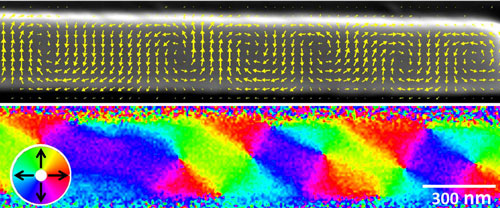| Dec 07, 2011 |
Researchers reveal magnetization textures in NiPd nanostructures
|
|
(Nanowerk News) An international collaboration led by the NIST Center for Nanoscale Science and Technology has used scanning electron microscopy with polarization analysis (SEMPA) to acquire images of the magnetic structure inside patterned nickel-palladium (NiPd) thin film nanostructures, revealing peculiar magnetization textures that can affect the behavior of these ferromagnetic alloys in experimental applications ("Magnetization textures in NiPd nanostructures").
|
 |
|
NiPd alloys are used for studying how ferromagnets affect nearby superconductors. They are also good electron spin injectors and spin analyzers being applied to the development of carbon nanotube-based electronics using electron spin ("spintronics").
|
|
The magnetic orientation of nano-patterned NiPd thin film contacts was expected to be simple, controlled primarily by the shape of the patterned film and the applied magnetic field. The SEMPA measurements, along with magnetic force microscopy and spin-polarized photoemission electron microscopy, revealed a surprisingly complex spatial structure of the magnetization. In some devices, the magnetization was even perpendicular to the expected direction.
|
|
The researchers found that complexity arises from stress-induced anisotropies caused by mismatches in both the lattice structures and the thermal expansion coefficients between the NiPd films and the underlying substrates. Although this stress-induced magnetic structure may be a problem for some applications, the researchers believe it can be used as a new route to control the orientation of the magnetization in nano-patterned electrodes.
|

